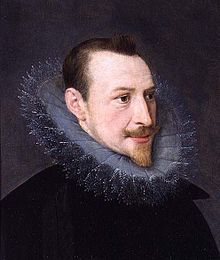Edmund Spenser
| Edmund Spenser | |
|---|---|
 |
|
| Born | 1552/1553 London, England |
| Died | 13 January 1599 (aged 46–47) London, England |
| Resting place | Westminster Abbey |
| Occupation | Poet |
| Language | English |
| Alma mater | Pembroke College, Cambridge |
| Period | 1569–1599 |
| Notable works | The Faerie Queene |
|
|
|
| Signature | |
Edmund Spenser (/ˈspɛnsər/; 1552/1553 – 13 January 1599) was an English poet best known for The Faerie Queene, an epic poem and fantastical allegory celebrating the Tudor dynasty and Elizabeth I. He is recognized as one of the premier craftsmen of nascent Modern English verse, and is often considered one of the greatest poets in the English language. He was deeply affected by Irish faerie mythology, which he knew from his home at Kilcolman and possibly from his Irish wife Elizabeth Boyle. His genocidal tracts against Gaelic culture were war propaganda. His house (ruins remain) was burned to the ground during the war, causing him to flee Ireland.
Edmund Spenser was born in East Smithfield, London, around the year 1552, though there is some ambiguity as to the exact date of his birth. As a young boy, he was educated in London at the Merchant Taylors' School and matriculated as a sizar at Pembroke College, Cambridge. While at Cambridge he became a friend of Gabriel Harvey and later consulted him, despite their differing views on poetry. In 1578, he became for a short time secretary to John Young, Bishop of Rochester. In 1579, he published The Shepheardes Calender and around the same time married his first wife, Machabyas Childe. They had two children, Sylvanus (d.1638) and Katherine.
In July 1580, Spenser went to Ireland in service of the newly appointed Lord Deputy, Arthur Grey, 14th Baron Grey de Wilton. Spenser served under Lord Gray with Walter Raleigh at the Siege of Smerwick massacre. When Lord Grey was recalled to England, Spenser stayed on in Ireland, having acquired other official posts and lands in the Munster Plantation. Raleigh acquired other nearby Munster estates confiscated in the Second Desmond Rebellion. Some time between 1587 and 1589, Spenser acquired his main estate at Kilcolman, near Doneraile in North Cork. He later bought a second holding to the south, at Rennie, on a rock overlooking the river Blackwater in North Cork. Its ruins are still visible today. A short distance away grew a tree, locally known as "Spenser's Oak" until it was destroyed in a lightning strike in the 1960s. Local legend has it that he penned some of The Faerie Queene under this tree.
...
Wikipedia
